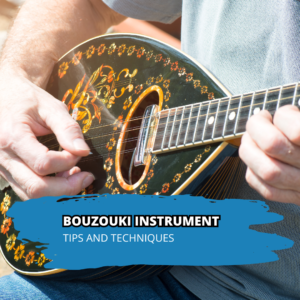Bouzouki Instrument Techniques: Playing Tips for Mastery

Mastery in Bouzouki Instrument Playing
The journey to mastering the bouzouki instrument is one of dedication and passion. Advanced techniques not only enhance the musicality and expressiveness of your performance but also open up new avenues for creativity and interpretation. A profound understanding of these techniques allows players to communicate the soul of their music more effectively, elevating their art to new heights. From the subtleties of finger placement to the dynamic control of the plectrum, every aspect contributes to the rich, vibrant sound that characterizes skilled bouzouki play. Mastery in bouzouki instrument playing is not just about technical proficiency; it’s about bringing the music alive in the most authentic way possible.
Building a Foundation for Advanced Techniques
Before delving into advanced techniques, it’s crucial to have a solid foundation in the basics of bouzouki instrument playing. This includes a firm grip on tuning, basic strumming patterns, and a clear understanding of the instrument’s layout. Strengthening these fundamental skills ensures that as you progress to more complex techniques, you have a stable base to build upon. It’s like constructing a building; the stronger the foundation, the higher and more complex the structure can be. Focusing on the basics also helps in developing a keen ear for music and rhythm, which is indispensable when tackling advanced bouzouki techniques.
Mastering Fingerpicking Patterns
The art of fingerpicking stands as a cornerstone of bouzouki instrument playing, offering a gateway to the intricate melodies and rhythms that the instrument is known for.
Essential Fingerpicking Techniques for the Bouzouki Instrument
Fingerpicking on the bouzouki instrument adds a level of intricacy and expressiveness to your music that strumming simply cannot achieve. It involves plucking the strings directly with your fingertips, fingernails, or picks attached to your fingers, allowing for a greater range of tones and dynamics. The key to mastering fingerpicking is starting with simple patterns and gradually increasing complexity. Practice slowly, focusing on the clarity of each note and the consistency of your timing. Remember, the goal is not only speed but also musicality and expression through the nuances of touch.
Advanced Fingerpicking Patterns and Exercises
As you become more comfortable with basic fingerpicking techniques, you can explore more advanced patterns that involve simultaneous plucking of non-adjacent strings, intricate rhythms, and the use of both the melody and accompaniment lines. To master these, incorporate exercises that challenge your dexterity and coordination, such as playing scales and arpeggios with fingerpicking patterns. Consistent practice of these exercises will significantly enhance your precision and fluidity on the bouzouki instrument, allowing you to execute complex pieces with ease and confidence.
Understanding Complex Rhythms
At the heart of bouzouki music lies the pulsating rhythms that bring life to its melodies.
Breaking Down Complex Rhythms in Bouzouki Music
Rhythm is the backbone of bouzouki music, giving it structure and momentum. Understanding complex rhythms involves recognizing the patterns and cycles within a piece, from the basic beats to the intricate syncopations and irregular time signatures that are characteristic of traditional and modern bouzouki compositions. Start by clapping or tapping out rhythms to internalize them before applying them to your playing. Listening extensively to skilled musicians can also provide insight into how these rhythms are executed effectively on the bouzouki instrument.
Practice Techniques for Mastering Rhythms
To master complex rhythms on the bouzouki, integrate metronome practice into your routine. Begin with a slow tempo, focusing on accuracy, and gradually increase the speed as you become more comfortable. Use a variety of rhythm exercises that challenge you to switch between different time signatures and syncopation patterns. This not only improves your rhythmic accuracy but also enhances your ability to adapt to different musical styles on the bouzouki instrument.
Enhancing Musical Expression through Improvisation
Improvisation is the bouzouki player’s canvas, where spontaneity and structure meet to create moments of musical magic.
The Role of Improvisation in Bouzouki Performance
Improvisation is a crucial aspect of bouzouki performance, allowing musicians to express their individuality and interact with the music in the moment. It requires a deep understanding of the bouzouki instrument, including scale patterns, modes, and the ability to anticipate chord progressions. Improvisation on the bouzouki is not just about spontaneous creation; it’s about making informed musical choices that enhance the piece while showcasing your unique voice as an artist.
Techniques and Tips for Improvisational Play
To develop your improvisational skills on the bouzouki, practice playing over backing tracks in various keys and styles. Focus on building a repertoire of licks and phrases that you can draw upon, and experiment with modifying these ideas to fit different musical contexts. Listening to and analyzing solos by accomplished bouzouki musicians can also provide valuable insights into effective improvisational strategies. Remember, the goal of improvisation is to connect with your music on a personal level, so let your creativity and emotional expression guide your playing.
Incorporating Traditional and Modern Playing Styles
For the musician, it’s an opportunity to honor the instrument’s rich heritage while contributing to its evolving story, blending the old with the new in a symphony of cultural expression.
Merging Traditional Techniques with Contemporary Music
The bouzouki instrument has a rich history, with roots in traditional Greek music that have evolved into modern interpretations and styles. Incorporating traditional playing techniques into contemporary music creates a unique sound that pays homage to the instrument’s heritage while pushing its boundaries. This fusion not only enriches the musical landscape but also ensures the continued relevance and vitality of the bouzouki. Explore different regional styles, learn from the masters of traditional bouzouki music, and experiment with integrating these techniques into your own compositions and arrangements.
The Evolution of the Bouzouki Instrument Playing Styles
The evolution of bouzouki playing styles reflects the instrument’s adaptability and the creativity of its players. From the classic rebetiko style to modern pop and rock adaptations, the bouzouki instrument continues to find its voice in a wide range of musical genres. Understanding this evolution is key to developing a versatile playing style that respects traditional techniques while embracing contemporary musical expressions. Study various genres of bouzouki music, experiment with different sounds and effects, and always be open to innovation in your playing.
Why Elite Music Academy is Your Ideal Choice for Bouzouki Lessons
Elite Music Academy offers bouzouki lessons that are tailored for individuals looking to master this unique instrument. Our instructors are seasoned bouzouki musicians with extensive experience in both traditional and modern playing styles. They are committed to guiding students through the intricacies of bouzouki techniques, from mastering fingerpicking patterns to understanding complex rhythms and improvisation. Elite Music Academy’s personalized approach to teaching ensures that each student’s learning journey is aligned with their musical goals and aspirations.
Whether you’re an intermediate player aiming to refine your skills or an advanced musician looking to push your boundaries, we provide the expertise, resources, and supportive environment necessary for mastering the bouzouki instrument. Join us to embark on a musical journey that honors the rich heritage of the bouzouki while embracing the creative possibilities of modern music!
FAQs
1. How long does it typically take to master the bouzouki instrument?
Mastering the bouzouki varies greatly among individuals, depending on practice frequency, musical background, and personal dedication. While proficiency can be achieved in a few years, true mastery is a lifelong journey.
2. Can beginners learn advanced techniques directly, skipping basics?
Skipping basics is not advisable. A solid foundation in the fundamentals of bouzouki playing is crucial for effectively learning and applying advanced techniques later on.
3. How does one transition from practicing basic to advanced bouzouki techniques?
Transition involves gradually incorporating more complex techniques into practice, building upon the basics with consistent, focused training and exploration of more challenging pieces.
4. What types of music can be played on the bouzouki?
The bouzouki is versatile, suited for traditional Greek music, rebetiko, and modern genres like pop and rock, reflecting its wide expressive capabilities.
5. What resources are recommended for intermediate players to advance their skills?
Intermediate players should explore advanced tutorials/lessons, study music theory, and engage with a community of musicians for feedback and inspiration.






